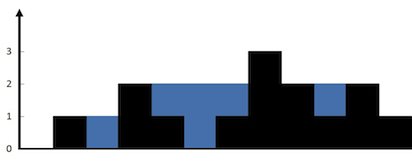42. Trapping Rain Water
题目
Given n non-negative integers representing an elevation map where the width of each bar is 1, compute how much water it is able to trap after raining.
For example,
Given [0,1,0,2,1,0,1,3,2,1,2,1], return 6.

The above elevation map is represented by array [0,1,0,2,1,0,1,3,2,1,2,1]. In this case, 6 units of rain water (blue section) are being trapped. Thanks Marcos for contributing this image!
题目大意
给定一系列的非负整数,把他们看成坐标轴上的数,如上图所示,黑色的就是用数字围成的墙,求这个容器可以装下多少水,也就是蓝色的部分可以有多少.
代码
1 | class Solution { |
解答
使用twopoint的思想,(使用twopoint的时候,貌似循环条件都是left<right 或者left<= right吧。。。)
首先应该知道,每个Bar上装的水的量取决于 左边最高的Bar和右边最高的bar中的较小值。
用left和right来指向本次循环处理哪个Bar(两边是交替着进行的,不像一个循环一样从左到右进行循环), leftmax和rightmax 分别来记录左边最大的Bar和右边最大的bar。
Author: corn1ng
Link: https://corn1ng.github.io/2017/11/10/算法/leetcode42/
License: 知识共享署名-非商业性使用 4.0 国际许可协议